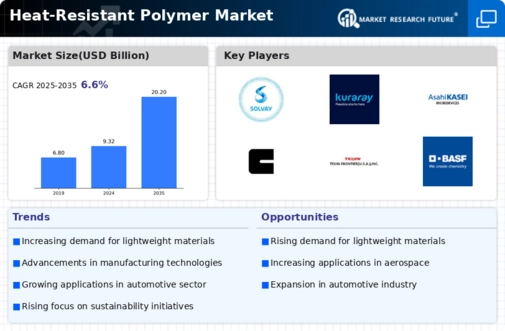Market Growth Projections
Growth in Automotive Applications
The automotive industry is a pivotal driver for the Global Heat-Resistant Polymer Market Industry, as manufacturers increasingly incorporate these materials to meet stringent performance standards. Heat-resistant polymers are utilized in various automotive components, including engine parts and electrical systems, where thermal stability is crucial. The ongoing transition towards electric vehicles is further amplifying this trend, as these vehicles require materials that can withstand higher operating temperatures. As a result, the market is anticipated to grow at a CAGR of 7.29% from 2025 to 2035, potentially reaching 20.2 USD Billion by 2035, indicating a robust future for heat-resistant polymers in automotive applications.
Rising Demand in Aerospace Sector
The Global Heat-Resistant Polymer Market Industry is experiencing heightened demand due to the aerospace sector's increasing reliance on advanced materials. As aircraft manufacturers seek to enhance fuel efficiency and reduce weight, heat-resistant polymers are becoming essential for components exposed to extreme temperatures. For instance, the use of polyimides in aerospace applications has surged, reflecting a broader trend towards lightweight materials. This shift is projected to contribute significantly to the market's growth, with the industry expected to reach 9.32 USD Billion in 2024. The aerospace industry's focus on innovation and performance is likely to drive further adoption of these materials.
Increasing Regulations on Emissions
Stringent environmental regulations are driving the demand for heat-resistant polymers in various industries, particularly in automotive and manufacturing. The Global Heat-Resistant Polymer Market Industry is responding to these regulations by providing materials that contribute to lower emissions and improved energy efficiency. For instance, the implementation of regulations aimed at reducing vehicle emissions has prompted automotive manufacturers to adopt lightweight and heat-resistant materials that enhance fuel efficiency. This regulatory landscape is expected to bolster market growth, as companies seek to comply with environmental standards while maintaining performance and safety.
Expanding Applications in Electronics
The electronics sector is increasingly adopting heat-resistant polymers due to the growing need for materials that can withstand high temperatures and provide electrical insulation. The Global Heat-Resistant Polymer Market Industry is benefiting from the proliferation of electronic devices that require reliable and durable components. For example, heat-resistant polymers are utilized in circuit boards and connectors, where thermal stability is paramount. As the demand for advanced electronics continues to rise, the market for heat-resistant polymers is likely to expand, driven by the need for materials that can endure the rigors of modern technology.
Technological Advancements in Material Science
Innovations in material science are significantly influencing the Global Heat-Resistant Polymer Market Industry. The development of new polymer formulations and processing techniques enhances the performance characteristics of heat-resistant materials. For example, advancements in nanotechnology have led to the creation of composites that exhibit superior thermal stability and mechanical strength. These technological breakthroughs not only improve the functionality of heat-resistant polymers but also expand their applicability across various industries, including electronics and manufacturing. As these innovations continue to emerge, they are likely to propel market growth and foster a competitive landscape within the industry.






















